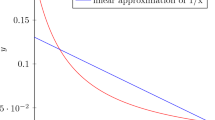Abstract
Vector-based homomorphic tallying remote voting schemes provide an efficient protocol for vote tallying, but they require voters to prove in zero-knowledge that the ballots they cast have been properly generated. This is usually achieved by means of the so-called zero-knowledge range proofs, which should be verified by the polling station before tallying. In this paper, we present an end-to-end verifiable hybrid proposal in which ballots are proven to be correct by making use of a zero-knowledge proof of mixing but still using a homomorphic tallying for gathering the election results. Our proposal offers all the advantages of the homomorphic tallying paradigm, while it avoids the elevated computational cost of range proofs. As a result, ballot verification performance is improved in comparison with the equivalent homomorphic systems. The proposed voting scheme is suitable for multi-candidate elections as well as for elections in which the votes have different weights.




Similar content being viewed by others
Notes
Our description assumes the elliptic ElGamal cryptosystem is being used.
References
Adida, B., Pereira, O., Marneffe, O.D., Quisquater, J.J.: Electing a university president using open-audit voting: analysis of real-world use of Helios. In: Electronic Voting Technology/Workshop on Trustworthy Elections (EVT/WOTE) (2009)
Akritidis, P., Chatzikian, Y., Dramitinos, M., Michalopoulos, E., Tsigos, D., Ventouras, N.: The votesecure\(^{\text{ TM }}\) secure internet voting system. In: Trust management (iTrust). LNCS, vol. 3477, pp. 420–423. Springer, Berlin, Heidelberg (2005)
Chaum, D.: Security without identification: transaction systems to make big brother obsolete. Commun. ACM 28(10), 1030–1044 (1985)
Chaum, D., Pedersen, T.P.: Wallet databases with observers. In: Advances in Cryptology—CRYPTO, LNCS, vol. 740, pp. 89–105 (1993)
Chow, S.S.M., Liu, J.K., Wong, D.S.: Robust receipt-free election system with ballot secrecy and verifiability. NDSS 8, 81–94 (2008)
Cohen, J.D., Fischer, M.J.: A robust and verifiable cryptographically secure election scheme (extended abstract). In: FOCS, pp. 372–382 (1985)
Cramer, R., Damgård, I., Schoenmakers, B.: Proofs of partial knowledge and simplified design of witness hiding protocols. In: Advances in Cryptology—CRYPTO, LNCS, vol. 839, pp. 174–187 (1994)
ElGamal, T.: A public key cryptosystem and a signature scheme based on discrete logarithms. IEEE Trans. Inf. Theory 31(4), 469–472 (1985)
Fujioka, A., Okamoto, T., Ohta, K.: A practical secret voting scheme for large scale elections. In: Advances in Cryptology—AUSCRYPT, LNCS, vol. 718, pp. 244–251 (1993)
Furukawa, J., Mori, K., Sako, K.: An implementation of a mix-net based network voting scheme and its use in a private organization. In: Towards Trustworthy Elections, LNCS, vol. 6000, pp. 141–154 (2010)
Groth, J.: Non-interactive zero-knowledge arguments for voting. In: Applied Cryptography and Network Security. LNCS, vol. 3531, pp. 467–482. Springer, Berlin, Heidelberg (2005)
Groth, J., Lu, S.: Verifiable shuffle of large size ciphertexts. In: Public Key Cryptography (PKC), LNCS, vol. 4450, pp. 377–392 (2007)
Hankerson, D., Menezes, A., Vanstone, S.: Guide to Elliptic Curve Cryptography. Springer, Berlin (2003)
Hirt, M., Sako, K.: Efficient receipt-free voting based on homomorphic encryption. In: Advances in Cryptology—EUROCRYPT, LNCS, 1807, pp. 539–556 (2000)
Ibrahim, S., Kamat, M., Salleh, M., Aziz, S.R.A.: Secure e-voting with blind signature. In: NCTT, pp. 193–197 (2003)
Juang, W.S., Lei, C.L.: A secure and practical electronic voting scheme for real world environments. IEICE Trans. Fund. Electron. Commun. Comput. Sci. 80, 64–71 (1997)
Katz, J., Myers, S., Ostrovsky, R.: Cryptographic counters and applications to electronic voting. In: Advances in Cryptology—EUROCRYPT, LNCS, vol. 2045, pp. 78–92 (2001)
Kiayias, A., Yung, M.: Self-tallying elections and perfect ballot secrecy. In: Public Key Cryptography (PKC), LNCS, vol. 2274, pp. 141–158 (2002)
Lee, B., Kim, K.: Receipt-free electronic voting scheme with a tamper-resistant randomizer. In: Information Security and Cryptology—ICISC, vol. 2002, pp. 389–406 (2003)
Mateu, V., Sebé, F., Valls, M.: Constructing credential-based e-voting systems from offline e-coin protocols. J. Netw. Comput. Appl. 42, 39–44 (2014)
Peng, K.: A general and efficient countermeasure to relation attacks in mix-based e-voting. Int. J. Inf. Secur. 10(1), 49–60 (2011)
Peng, K.: An efficient shuffling based evoting scheme. J. Syst. Softw. 84(6), 906–922 (2011)
Peng, K., Aditya, R., Boyd, C., Dawson, E., Lee, B.: Multiplicative homomorphic e-voting. In: Progress in Cryptology—INDOCRYPT, LNCS, vol. 3348, pp. 61–72 (2004)
Peng, K., Bao, F.: Efficient multiplicative homomorphic e-voting. In: Information Security Conference—ISC 2010, LNCS, vol. 6531, pp. 381–393 (2011)
Peng, K., Dawson, E., Bao, F.: Modification and optimisation of a shuffling scheme: stronger security, formal analysis and higher efficiency. Int. J.Inf. Secur. 10(1), 33–47 (2011)
Sebé, F., Miret, J.M., Pujolàs, J., Puiggali, J.: Simple and efficient hash-based verifiable mixing for remote electronic voting. Comput. Commun. 33(6), 667–675 (2010)
Yi, X., Okamoto, E.: Practical remote end-to-end voting scheme. In: EGOVIS, LNCS, vol. 6866, pp. 386–400 (2011)
Acknowledgments
The authors acknowledge partial support by the Spanish Government under Projects CSD2007-0004, IPT-2012-0603-430000 and MTM2013-46949-P, and by the Government of Catalonia under Grant 2014SGR-1666.
Author information
Authors and Affiliations
Corresponding author
Rights and permissions
About this article
Cite this article
Mateu, V., Miret, J.M. & Sebé, F. A hybrid approach to vector-based homomorphic tallying remote voting. Int. J. Inf. Secur. 15, 211–221 (2016). https://doi.org/10.1007/s10207-015-0279-8
Published:
Issue Date:
DOI: https://doi.org/10.1007/s10207-015-0279-8




